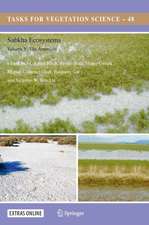Sabkha Ecosystems: Volume II: West and Central Asia: Tasks for Vegetation Science, cartea 42
Editat de M. Ajmal Khan, Benno Böer, German S. Kust, Hans-Jörg Barthen Limba Engleză Hardback – 22 sep 2006
| Toate formatele și edițiile | Preț | Express |
|---|---|---|
| Paperback (1) | 792.49 lei 38-44 zile | |
| SPRINGER NETHERLANDS – 18 noi 2010 | 792.49 lei 38-44 zile | |
| Hardback (1) | 958.56 lei 43-57 zile | |
| SPRINGER NETHERLANDS – 22 sep 2006 | 958.56 lei 43-57 zile |
Din seria Tasks for Vegetation Science
-
 Preț: 34.59 lei
Preț: 34.59 lei - 18%
 Preț: 1219.16 lei
Preț: 1219.16 lei - 20%
 Preț: 554.66 lei
Preț: 554.66 lei -
 Preț: 394.12 lei
Preț: 394.12 lei -
 Preț: 396.02 lei
Preț: 396.02 lei -
 Preț: 402.76 lei
Preț: 402.76 lei - 24%
 Preț: 790.13 lei
Preț: 790.13 lei - 18%
 Preț: 1825.75 lei
Preț: 1825.75 lei - 18%
 Preț: 1218.69 lei
Preț: 1218.69 lei - 24%
 Preț: 784.53 lei
Preț: 784.53 lei - 18%
 Preț: 1233.69 lei
Preț: 1233.69 lei -
 Preț: 73.90 lei
Preț: 73.90 lei - 18%
 Preț: 1222.01 lei
Preț: 1222.01 lei - 18%
 Preț: 952.09 lei
Preț: 952.09 lei - 18%
 Preț: 1225.94 lei
Preț: 1225.94 lei -
 Preț: 388.31 lei
Preț: 388.31 lei -
 Preț: 391.40 lei
Preț: 391.40 lei - 18%
 Preț: 1220.45 lei
Preț: 1220.45 lei - 18%
 Preț: 949.23 lei
Preț: 949.23 lei - 18%
 Preț: 943.73 lei
Preț: 943.73 lei - 18%
 Preț: 1238.11 lei
Preț: 1238.11 lei - 18%
 Preț: 1232.26 lei
Preț: 1232.26 lei - 24%
 Preț: 796.72 lei
Preț: 796.72 lei - 24%
 Preț: 1068.94 lei
Preț: 1068.94 lei -
 Preț: 368.39 lei
Preț: 368.39 lei - 18%
 Preț: 1230.03 lei
Preț: 1230.03 lei - 24%
 Preț: 783.41 lei
Preț: 783.41 lei - 18%
 Preț: 948.16 lei
Preț: 948.16 lei - 18%
 Preț: 948.61 lei
Preț: 948.61 lei - 24%
 Preț: 1053.39 lei
Preț: 1053.39 lei
Preț: 958.56 lei
Preț vechi: 1168.98 lei
-18% Nou
Puncte Express: 1438
Preț estimativ în valută:
183.42€ • 191.99$ • 152.66£
183.42€ • 191.99$ • 152.66£
Carte tipărită la comandă
Livrare economică 31 martie-14 aprilie
Preluare comenzi: 021 569.72.76
Specificații
ISBN-13: 9781402050718
ISBN-10: 1402050712
Pagini: 280
Ilustrații: XVI, 263 p.
Dimensiuni: 210 x 297 x 23 mm
Greutate: 0.82 kg
Ediția:2006
Editura: SPRINGER NETHERLANDS
Colecția Springer
Seria Tasks for Vegetation Science
Locul publicării:Dordrecht, Netherlands
ISBN-10: 1402050712
Pagini: 280
Ilustrații: XVI, 263 p.
Dimensiuni: 210 x 297 x 23 mm
Greutate: 0.82 kg
Ediția:2006
Editura: SPRINGER NETHERLANDS
Colecția Springer
Seria Tasks for Vegetation Science
Locul publicării:Dordrecht, Netherlands
Public țintă
ResearchCuprins
Sabkha ecosystem and halophyte plant communities in Saudi Arabia.- An overview of the halophytes in Turkey.- The biogeography of the coastal vegetation of the Abu Dhabi gulf Coast.- The sabkha vegetation of the United Arab Emirates.- Desertification and sabkhat formation in the Aral Sea region.- Biodiversity of halophytic and sabkha ecosystems in Iran.- The micro-organisms of sabkhat in Qatar.- Soil salinization and floodplain ecosystems of south-west Turkmenistan.- Economic halophytes of Bahrain.- The main regularities of dust-salt transference in the desert zone of Kazakhstan.- Halophytes of Pakistan: characteristics, distribution and potential economic usages.- Floristic composition of a threatened Mediterranean sabkhat of Sinai.- Salt lake area, northeastern part of Dukhan Sabkha, Qatar.- Salinization processes and sabkhat formation in the valleys and ancient deltas of the Murgab and Tedgen rivers in Central Asia.- Properties and functioning of pedolithogenic complexes of soils, rocks and waters of the forest steppe of Western Siberia.- Natural, geographical, halogeochemical and soil features of Western Siberia.- Sabkhat regions of Iraq.- The dynamics of halophyte ecosystems in the zone of impact of Kapchagai reservoir (Kazakhstan).- Landscape ecology and cartographical analysis of natural salt complexes in the south west Siberia Basins of Lake Chany and Lake Kulundinskoye.- Salinity of irrigated lands of Uzbekistan: causes and present state.
Textul de pe ultima copertă
Sabkha Ecosystems Volume I: The Arabian Peninsula and Adjacent Countries was published in 2002. It was the first comprehensive volume dealing with the subject of sabkha research, and sabkha environmental management. Valuable new information was provided for the sabkha of numerous countries on and adjacent to the Arabian Peninsula. This new volume now follows up on this important process, and provides data and information on salt desert ecosystems of numerous West and Central Asian countries, including many of which are located in the Arabian Peninsula. The information provided assists the reader to better understand sabkha geology, hydrology, geomorphology, zoology, botany, ecology, ecosystem functioning, as well as sabkha conservation, utilisation, and development. The volume is paramount literature for anyone dealing with sabkha research and development.
Caracteristici
New information on salt desert ecosystems in many countries, valuable for researchers, and developers Essential information for developers and researchers for professional R and D planning Sabkha Ecosystems are widely considered wastelands, however, they have an ecosystem value, a development value, a conservation value, and this needs to be understood for professional environmental management























